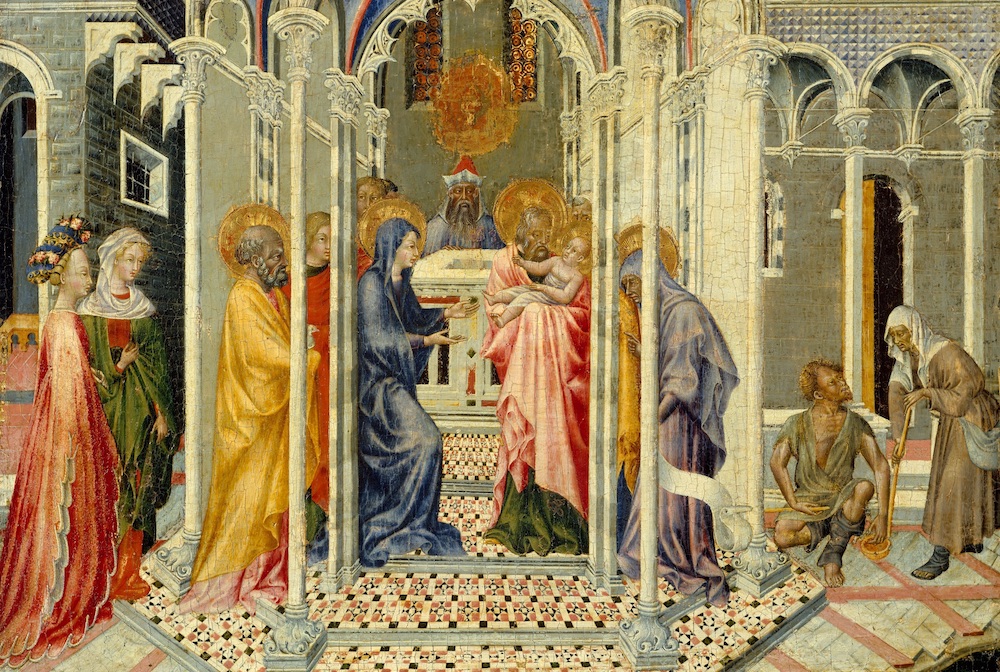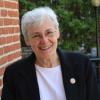
Detail of painting "The Presentation of Christ in the Temple" by Giovanni di Paolo, circa 1435 (Metropolitan Museum of Art)
It takes a village to raise a child. That's a subtle, unspoken assumption in Luke's account of the first time Jesus entered the temple. As Luke tells his story, he depicts Joseph, Mary and all of Israel as part of the scene when Jesus first entered what he would call his father's house.
Although Luke is careful to insist that the family went to fulfill the law, as soon as they arrived, their ritual reasons for being there were sidelined as the chosen people came to the fore in the guise of two elders. Just as Elizabeth and Zechariah, the Baptist's parents, had symbolized Sarah and Abraham, Anna and Simeon recall the story of Hannah who brought her son Samuel to Eli in the temple where holy women watched the scene. These details situate the infant Jesus in the center of the history of his own people. The village that produced and raised him stretches back 2,000 years to God's covenant with Abraham. Jesus belongs to the chosen people by law, by heritage and by recapitulating their history in himself.
There's a unique beauty and important Gospel theme depicted by the fact that while Jesus' entry into the temple symbolized his membership in the people of God, the individuals who recognized and welcomed him were simple elders. The temple would have been swarming with ordinary folk like Anna and Simeon, along with authorities like scribes, Pharisees, priests and other officials. In the midst of all of them, it was Simeon, a man with no titles but a sterling reputation, who, as he held the child, somehow beheld everything he had ever hoped for.
With his predictions about Jesus, Luke allowed Simeon to foreshadow the rest of the Gospel story. Then, came Anna, the ancient widow who spent her life in prayer. While Simeon prayed in thanksgiving and spoke to Mary and Joseph, Anna took on the role of being the first evangelist, announcing Jesus' presence to all who were awaiting redemption.
When we envision all that happens in this story, we begin to realize that the Feast of the Holy Family is really not about a nuclear family of two parents and an only child, but a celebration of human community. This story and its symbolism introduce us to a web of relationships that grows exponentially as each of the original characters comes in touch with others who spread the word to their relations, and on and on, from age to age.
Advertisement
Our communities are particularly important as we celebrate the family on this Sunday after Christmas. Many families will be basking in Christmas memories and enjoying the gifts they received just two days ago. At the same time, a great number of our people did not celebrate the season with an intact nuclear or extended family. For many, the holidays highlight the hurts of broken marriages, family feuds, or the loss of loved ones. If Christmas was hard for them, the Feast of the Holy Family can feel like a day of unnecessarily rubbing salt in their wounds.
In order to make this feast more accessible to all, we might take our cue from Luke and celebrate it as a feast of our ever-expanding community of loving relationships. With that perspective, we can enjoy Sirach's wisdom about respecting parents as a reminder to be grateful for all we have received from our elders: parents and extended family, the pillars of the parish, retired religious women, and our ancestors in faith.
Today's optional reading from Genesis invites us to remember our roots in the Jewish tradition and to stand with Abraham as he wondered if God's promises could ever come true. God's covenant with Abraham started the storyline in which God fulfills promises to accomplish the impossible with people who strive to be faithful.
The Letter to the Colossians offers a meditation about how to build up our communities. The key idea is to allow love to be "the bond of perfection" among us. That does not mean that we will be perfect, but that our bonds of love will outweigh the imperfections that tear a community apart when we give them too much importance.
The Feast of the Holy Family certainly celebrates families. On a larger scale, it invites us to cherish and develop our ability to participate in communities of love. We are created for God, in the image of the Triune God whom we know as a constantly expanding, all-encompassing community of love. Like Jesus, we all have the ability to enter into and form the communities that make us more human and more godlike.
The family we really celebrate today is the whole, holy family of humankind, bound together across the ages by the God who loves us into life — now and forever, amen.
[St. Joseph Sr. Mary M. McGlone serves on the congregational leadership team of the Sisters of St. Joseph of Carondelet.]
